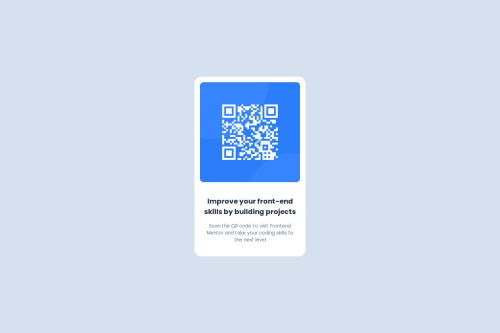CSS for styling a QR code component

Solution retrospective
It was a simple template, just created some CSS rules and it worked well.
What challenges did you encounter, and how did you overcome them?Couldn't find the specs of the fonts, sent the repo anyway.
Please log in to post a comment
Log in with GitHubCommunity feedback
- @DylandeBruijn
@luisgustavogorniak
Hiya! 👋
Congratulations on your solution, it looks very close to the design! I can tell you put a lot of effort into it.
Things you could improve ✍️
-
I suggest adding a bit of
paddingto yourbodyelement so the card has some space around it on smaller viewports. -
You could add a
min-height: 100vhto yourbodyelement so it takes up the full height of the viewport while still being able to grow when the content inside it grows. -
Try experimenting with CSS variables, they help you make your CSS values more reusable across your code.
-
I suggest using clear descriptive CSS classes like
.card,.card-titleand.card-description. -
Try using semantic HTML elements like
main,sectionandarticle. -
Try using using relative CSS units like
remandemthey make your layout more adaptable. -
Be careful with setting a fixed
widthandheighton your elements. If the content in these elements grows beyond these restrictions you’ll run into overflow issues. Keeping theheightatauto- whichblockelements are by default - will be fine in most cases. -
You have a bit of placeholder text at the top of your solution which breaks your layout.
I hope you find my feedback helpful! 🌟
Let me know if you have more questions and I'll do my best to answer them. 🙋♂️
Happy coding! 😎
Marked as helpful -
- @luisgustavogorniak
Thank you so much for your feedbak! I really appreciate it! Did some changes as you suggested, it looks a little closer now. It still needs more work on the margin and padding of the card elements I guess.
Join our Discord community
Join thousands of Frontend Mentor community members taking the challenges, sharing resources, helping each other, and chatting about all things front-end!
Join our Discord